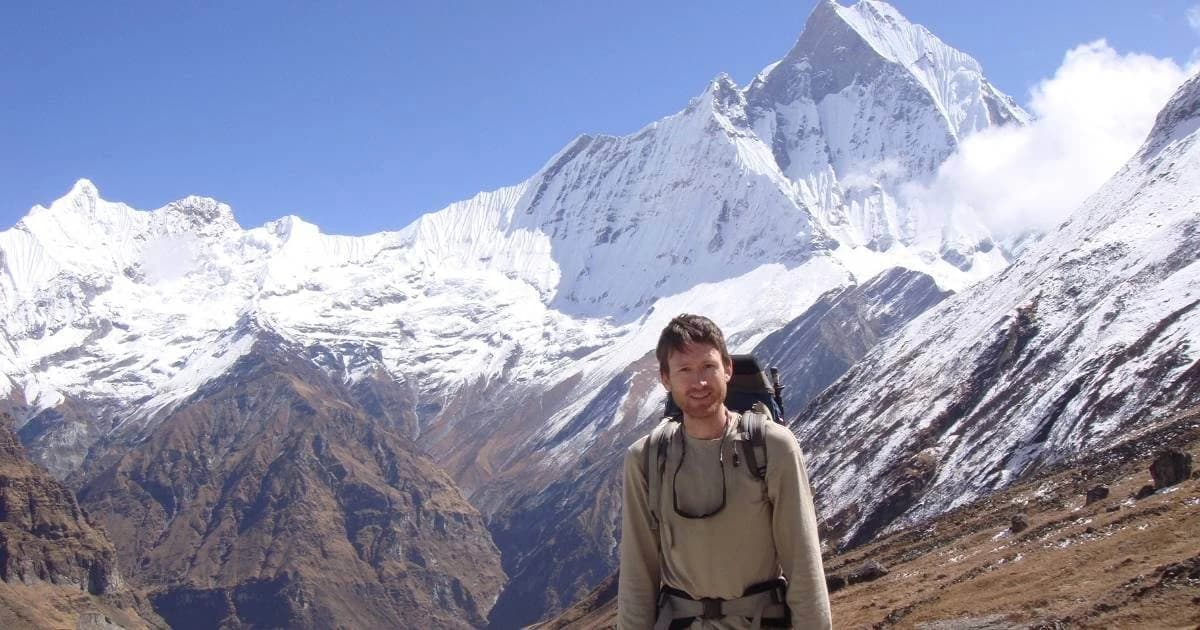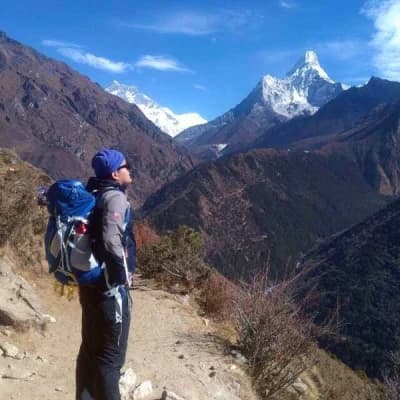The best times to visit the Annapurna Base Camp trek are in the spring, from March to May, and autumn, from September to November. These seasons are favorites for trekkers because the weather is usually excellent, and you can enjoy clear views of the mountains. Spring brings the added beauty of blooming rhododendrons, while autumn is known for its crisp, clear skies.
The Annapurna Base Camp (ABC) is an exhilarating trek for passionate hikers and nature enthusiasts in the Annapurna trekking region! It’s breathtaking, with majestic mountains and inviting trails, promising a unique seasonal escapade filled with adventure and thrill.
But when is the best time to visit Annapurna Base Camp, put on your hiking boots, and hit these scenic trails? Well, it’s not just about picking a date and packing your bags; it’s about syncing your trek with weather and trail conditions to get the most out of this journey.
Let’s explore what each season offers to help you plan the ideal trekking adventure.
Peak Seasons to Visit Annapurna Base Camp
1. Spring (March To May)
- Crowd Levels: High, one of the busiest trekking seasons.
- Trail Condition: Generally clear and dry, with some muddy sections early in the season.
- Weather: Mild temperatures, occasional rain showers, and blooming rhododendrons.
- Accommodation Availability: Limited; booking well in advance is advised.
Spring is an excellent time to trek to Annapurna Base Camp (ABC). Daytime temperatures are comfortable, generally between 50°F and 68°F, making it ideal for trekking. However, nights can get cold, sometimes dropping to around 23°F.
Since spring is a popular season for hiking in ABC, expect to share the trails and rest stops with other adventurers. ABC is bustling during this time, which adds to the camaraderie of the trekking experience.
One of the best reasons to visit ABC during spring is the stable weather, which offers less risk of unexpected snow or extreme cold. This makes for safer and more predictable hiking conditions.
Ensuring your safety and comfort is our utmost priority. With the right preparations, such as warm clothing for chilly nights and protective gear for sunny days, you can go on a comfortable and secure journey. We are here to guide you every step of the way.
→ Read: What to pack for Annapurna Base Camp Trek?
2. Autumn/Fall (September To November)
- Crowd Levels: High, peak trekking season.
- Trail Condition: Clear and dry, excellent conditions for trekking.
- Weather: Clear skies, mild temperatures, and minimal rainfall.
- Accommodation Availability: Limited booking in advance is highly recommended.
Autumn, usually in September, October, and November, is the best time for the Annapurna Base Camp trek. The weather is generally stable, with clear skies and pleasant temperatures.
It’s around 50°F to 59°F during the day, so it’s comfortable for trekking. But at night, it can get as cold as 14°F, so bring warm clothes and gear.
Trekking during the fall is a feast for the eyes, with stunning mountain views and the fresh, cool air inspiring a sense of wonder. It’s a trek that will leave you with unforgettable memories.
Also, many local festivals, such as Dashain and Tihar, and celebrations during this time add even more excitement to the journey.
Fall is an excellent time to do the ABC trek. During this season, many people worldwide go on this trek, so the trails and places to stay might be more crowded than usual.
Even though it can get crowded, the stunning natural surroundings and lively vibe make the ABC trek a delightful and unforgettable experience.
Off-Peak Seasons to do Annapurna Base Camp Trek
The off-peak seasons for visiting Annapurna Base Camp, from June to August and December to February, offer different beauty and tranquility. While the weather can be unpredictable, the trails are less crowded, providing a serene trekking experience. Here, you can immerse yourself in the peaceful beauty and solitude of the mountains, away from the usual hustle and bustle of the busier months.
However, be careful during these seasons, as the less predictable weather can present unexpected challenges on the trails.
1. Summer/Monsoon (June To August)
- Crowd Levels: Moderate, fewer tourists due to weather.
- Trail Condition: Wet, muddy, and slippery; risk of landslides and leeches.
- Weather: Warm to hot, frequent rain, high humidity. Risk of thunderstorms and heavy downpours.
- Accommodation Availability: generally available, but booking in advance is still recommended.
In Nepal, during the summer, which is also the monsoon season, there can be a lot of rain. This can make the pathways slippery and muddy. The daytime temperatures usually range from 59°F to 77°F, but because it’s pretty humid, it might feel even warmer than that.
Summer might be ideal if you don’t mind a little rain and seek a peaceful trek. Just be aware that there may be leeches and occasional landslides while trekking in the summer.
To tackle these challenges, pack appropriately: wear full-length clothing and anti-slip boots to navigate muddy paths safely, and don’t forget a high-quality rain jacket and waterproof pants to stay dry.
A wide-brimmed hat can be a real-life savior. It shields you from the sun’s intensity and frequent rain showers, keeping your face dry and comfortable.
Although the trails are less crowded during the monsoon, which is excellent for those seeking solitude, be mindful that the weather can also affect travel plans, including causing flight delays or cancellations. If you’re on a tight schedule or have connecting flights, allocating extra travel days is wise to accommodate any unexpected changes.
Trekking to Annapurna Base Camp during the summer or monsoon season offers a unique and memorable experience, distinctly different from other times of the year. With the proper preparations and a flexible attitude, you can enjoy an unforgettable adventure amidst Nepal’s lush, rain-washed landscapes.
2. Winter (December To February)
- Crowd Levels: Low, fewer hikers.
- Trail Condition: Icy, snow-covered; some trails may be closed. Requires proper winter gear.
- Weather: Cold, snowy, potentially severe conditions.
- Accommodation Availability: More available, possibly cheaper, but some services may be closed.
If you’re up for a thrilling winter journey, trekking from December to February could be the best time to visit Annapurna Base Camp. During these months, daytime temperatures hover between 5°C to 10°C (41°F to 50°F), but as night falls, they can plummet to as low as -20°C (-4°F), especially in higher altitudes.
Trekking ABC in winter allows you to experience the unique natural beauty of the Himalayas. Imagine walking along trails blanketed in pristine snow, surrounded by the quiet of untouched nature—it’s a truly magical experience. With fewer trekkers around, the sense of peace and tranquility is profound.
However, winter trekking has challenges. The trails can be covered in snow, increasing the risk of avalanches and making it a risky time for hiking. Therefore, winter trekking to Annapurna Base Camp is generally not recommended for beginners or those without experience in winter hiking.
To ensure comfort and safety, you should dress appropriately with thick, warm coats and other cold-weather gear to protect against the severe cold.
→ Beginners Guide To Annapurna Base Camp Trek
Advantages Of Trekking In Different Seasons
Trekking in Annapurna Base Camp is not just a journey; it’s an adventure that unfolds differently each season, offering unique and thrilling experiences. Here’s a glimpse of the excitement that awaits you in each season:
- Spring: Trekking in spring allows you to see nature return to life. The weather is mild, flowers bloom, and the landscape is green. The paths have fewer people, and the animals are livelier.
- Summer: Summer trekking offers long daylight hours, warm temperatures, and clear skies. It’s the perfect time for high-altitude trekking and exploring alpine meadows.
- Autumn: Autumn brings a stunning display of colorful foliage. The cool, crisp air and decreased chances of rainfall make for comfortable hiking conditions. The trails are adorned with hues of red, orange, and yellow.
- Winter trekking offers an entirely different allure. The landscapes blanketed in snow, exude a serene and magical charm, creating an atmosphere of tranquility. With fewer hikers on the trails, you can savor a more solitary and meditative trekking experience, truly immersing yourself in the beauty of the surroundings.
->Read: How To Prepare For Annapurna Base Camp Trek
When Does The Annapurna Base Camp Trek Tend To Be Busy?
When planning a trek to Annapurna Base Camp, it’s essential to consider the best time to visit to avoid the crowds and fully enjoy the experience. The trek tends to be busiest during the peak seasons: spring (March to May) and autumn (September to November). During these times, the trail can get quite crowded as many trekkers flock to the region to take advantage of the favorable weather conditions and clear mountain views.
If you prefer a quieter trekking experience, you may want to consider visiting during the off-season months, such as the monsoon season (June to August) or the winter season (December to February). During these times, the number of trekkers on the trail tends to decrease significantly, offering a more serene experience with less crowded teahouses and quieter trails. However, it’s important to note that the offseason comes with challenges, including potential risks of landslides during the monsoon season and colder temperatures during the winter months.
The best time to visit Annapurna Base Camp depends on what you like and how much you can tolerate different weather and crowded trails. For the best weather, go during the busy season or a quieter time during the offseason. Either way, careful planning and getting ready for your trek will ensure you have a great time and many incredible memories at this beautiful place.
If you need any help or advice about trekking to the Annapurna Base Camp or want to know more about our trekking packages, feel free to contact Tidy Himalaya, the best trekking company in Nepal.
Best Time to Visit Annapurna Base Camp FAQs
How cold is Annapurna Base Camp in March?
During March, the temperatures at Annapurna Base Camp typically vary from 10°C to 15°C (50°F to 59°F) in the daytime. Nights are significantly colder, often reaching around -5°C (23°F). Dressing in layers is essential to ensure warmth during chilly nights.
Is Annapurna Base Camp crowded?
Annapurna Base Camp can get busy, especially during the most popular trekking times. In spring, March is a good time to go as it’s less crowded than April and May and offers a more peaceful trekking experience. Even when it’s busy, the crowds are manageable and don’t spoil the beauty of the trek.
How hard is the base camp at Annapurna?
Annapurna Base Camp trek can be challenging. You’ll walk 6-7 hours daily, with both uphill and downhill terrain. The high altitude can make some people feel unwell, so being in good shape, having some hiking experience, and getting used to the altitude are important for a safe and enjoyable trek.
Which month is best for ABC trekking?
The ABC trek is best done during the spring (March to May) and autumn (September to November) months. The weather is generally clear during these times, and the bright skies and moderate temperatures make for ideal trekking conditions. This allows trekkers to enjoy the stunning views of the Himalayas and the surrounding landscapes.
Why is Annapurna Base Camp famous?
Annapurna Base Camp is renowned for its natural beauty. It gives the best views of the Annapurna and Dhaulagiri mountain ranges and diverse wildlife. The journey includes terraced fields, rhododendron forests, and high mountain terrain. Interacting with local communities adds to the experience, and reaching the base camp is fulfilling for many hikers.
Recommended Read: Why is Annapurna Base Camp Popular
Can I trek to Annapurna base camp during the monsoon?
It is possible to trek to Annapurna Base Camp during the monsoon (June to August). However, be prepared for wet and slippery conditions, leeches, and occasional landslides. The trails are less crowded, and the landscapes are lush and green.


.webp&w=1200&q=75&dpl=dpl_2PwU5ZDv8uoJ3KrzEVbz8N547HgX)
.webp&w=1200&q=75&dpl=dpl_2PwU5ZDv8uoJ3KrzEVbz8N547HgX)
.webp&w=1200&q=75&dpl=dpl_2PwU5ZDv8uoJ3KrzEVbz8N547HgX)